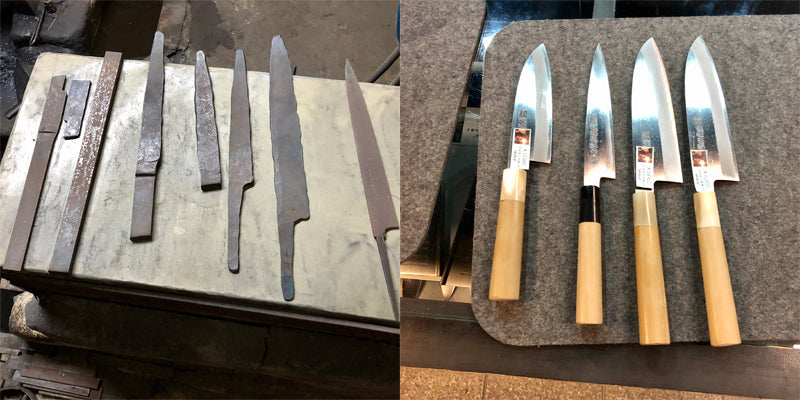It’s not always about the food…
Periodically when we travel to Japan, we sometimes visit artisans that do not make food items. Incredible things still often just fall into our laps.
Knife Maker in Sakai
Chris and I have been searching for not only amazing pantry items, but artisan tools, cookware and tableware as well. On one journey Doi-san (of Doi Konbu) took us deep into Sakai, a section of Osaka known for having a number of small, artisan knife makers. We visited his knife maker friend Mizuno-san.

Mizuno-san crafting a knife from a block of steel.
Mizuno-san led us through his store and into his small workshop where it was dark and smelled of earthy steel & smoke. Using only heat, hammers & muscle, Mizuno-san took a rectangular piece of steel and turned it into an unfinished blade right in front of us in less than 10 minutes. It was fascinating to see him at work, heating the steel, pounding it, heating it again, cooling it in water. He did everything by feel, using every sense except taste to know what to do next. It was such an honor to watch someone who is so skilled at their craft make something so fluidly.

Later Mizuno-san continued to teach us about knives in Japan including Sakai’s history in metalworking and the breadth and depth of knives in Japan. With over 300 different types of knives, it is a subject that demands a deep dive and study to understand. We are still in awe.
Binchotan
Think about it…our use of charcoal goes back to prehistory when humans first discovered how to use fire. It really is an ancient ‘technology’. And back in February of 2019 in beautiful Wakayama Prefecture we were able to witness how artisanal charcoal (Binchotan in Japanese) is made. Binchotan is known for being incredibly hard and producing very high temperatures. It is a must for making proper yakitori.
We drove to Wakayama to meet Tsuchiya-san who was going to show us binchotan making. He was a gregarious type of guy, always cracking jokes, etc. Tsuchiya-san is also a farmer. He gave us some of his shiitake and deliciously sweet mikan (a citrus fruit) to try. Then we followed him further into the countryside to his hillside kiln. There, he explained the process – from the type of wood (oak) to the amount of time in the kiln (over a week). His kiln was idle at the time, so we actually were able to climb inside. Dark and smelling deeply of smoke, it was eerie in there, especially knowing how hot the inside of the kiln gets when making binchotan.

We really wanted to see a kiln in production so we drove to Tanabe City to Kishu Binchotan Memorial Park (gotta love Japan!) where there were five working charcoal kilns. We were lucky enough to see the beginning and the end of the process. For the beginning we saw a charcoal maker splitting logs by hand into the right size & thickness to make the style of binchotan he was after. And at the other end of the process, we were able to witness the removal of the finished binchotan from the screamingly hot kiln. It takes a lot of skill, guts & sweat to carefully remove the glowing pieces of binchotan. After removing them from the kiln, the pieces are buried in sand and ash to stop the combustion. Through the whole process, we didn’t see one piece of mechanical equipment…this is all done by hand, just like it has been for a very, very long time.

Tea Ceremony
My Japanese “mother”, Yoko, is a tea sensei (teacher). My first trip when I met her, Yoko took me to her tea class (she was only a student then). I loved the process, tea and food, but man, my legs were aching from kneeling so much. As time went on, I really fell in love with matcha and I started drinking it regularly back home in San Francisco.
When I went back to visit Yoko, I had asked if we could have matcha. So, we did a simple ceremony in her kitchen. The process is very involved and requires very specific movements. I tried but obviously had a lot to learn. A few trips later, Chris had his turn being Yoko’s student and, judging by the amount of laughing from Yoko, he has even more to learn.

It turns out that Takehiro Wada of Wadaman is also studying tea ceremony. One night during one of our trips he took us to one of his classes. His sensei is a good-natured fellow and was very forgiving of us gaijin (literally, Japanese for “outside person”) as we kneeled uncomfortably and stumbled our way through the movements. We are grateful for both the opportunity to participate and the patience we were shown.
Truth be told, I love tea ceremonies. They are always special and unique, but my knees actually prefer the cold brew matcha I make at home.
Shochu and more in Kagoshima
When we went to down to Kagoshima, we were lucky to be connected with a local farmer. Incredibly generous with his time, Miyahara-san proudly showed us around his city and parts of the local countryside. A few of the highlights include: devouring a delicious sashimi lunch at a beachside restaurant on the wild west coast of Kyushu, tasting locally-sourced teas at Susumuya tea shop and getting a crash course in making (delicious & strong) shochu at Yamato Zakura. We are forever indebted to Miyahara-san for his kindness and for helping us understand what a special place Kagoshima is.



